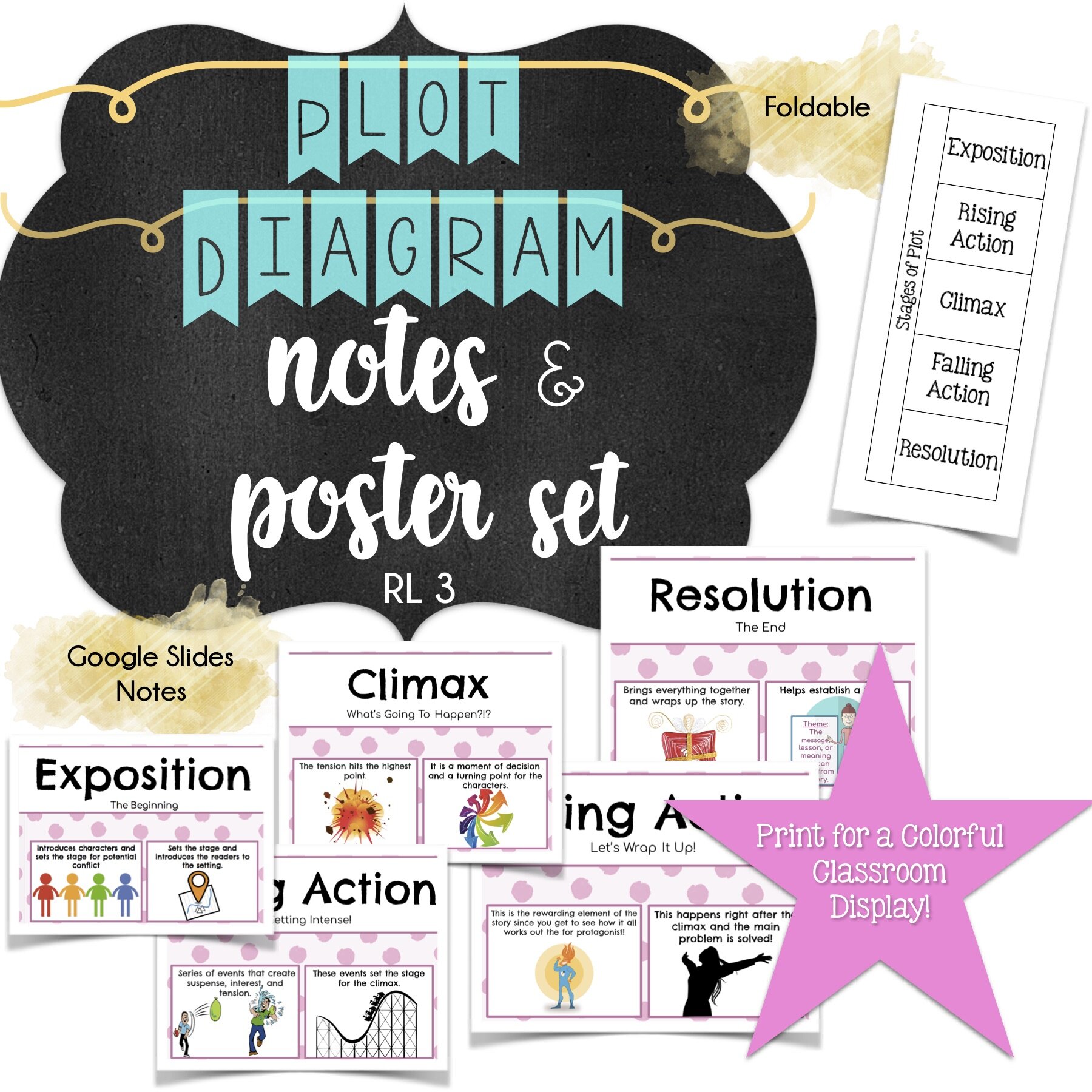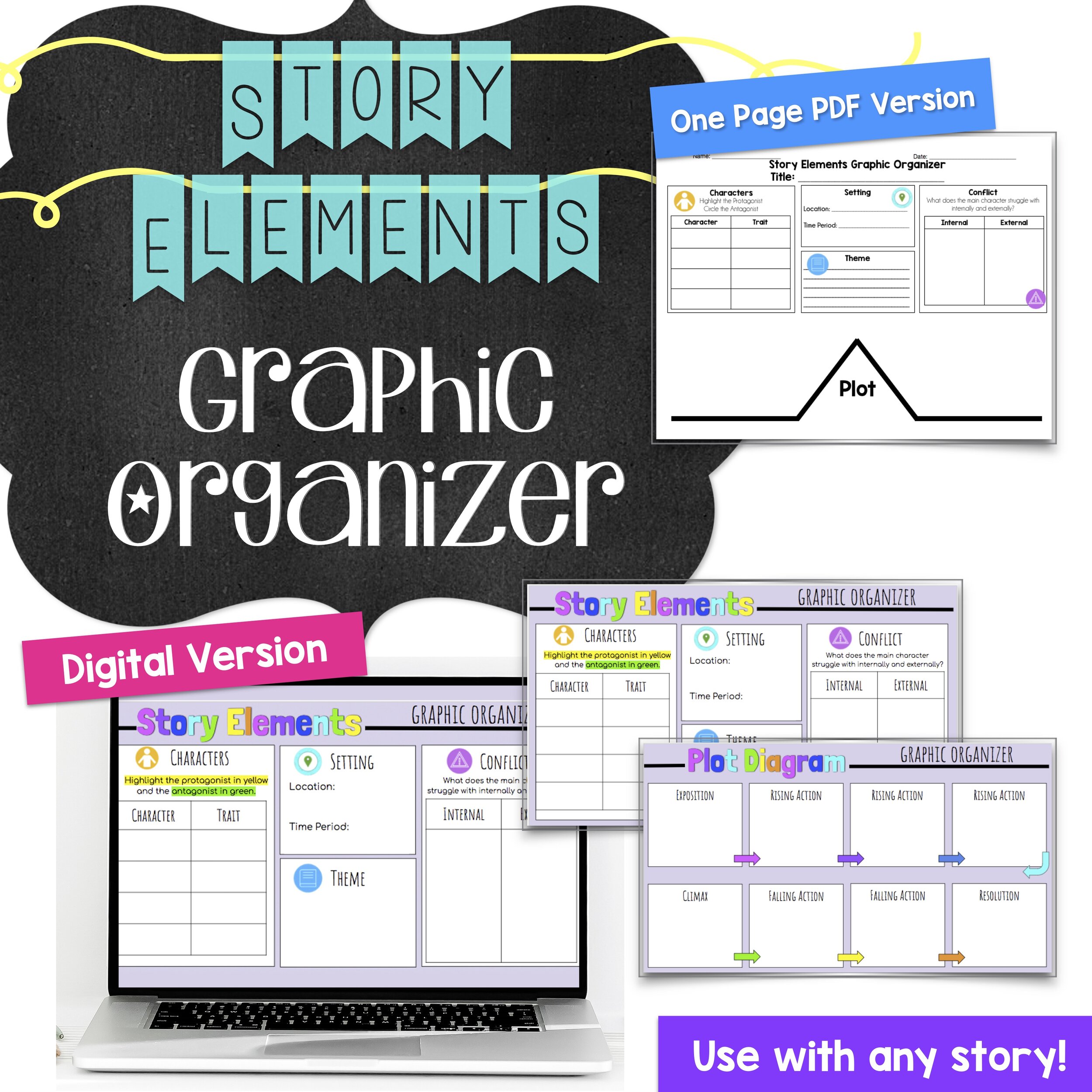Story Elements
Story Elements Poster Set
This colorful, engaging, and fun poster set will easily help you teach and reinforce the story element vocabulary. This set is perfect for a bulletin board, anchor chart, or as reference material on your digital learning platform.
Download includes Posters for:
Protagonist
Antagonist
Plot
Setting
Conflict
Theme
Plot Diagram Poster Set
These colorful and easy to print posters are a perfect addition to your classroom decor!
You can also put them on your digital learning platform as a reference.
Download Includes:
6 Colorful Posters with definitions
Story Elements Pre-Assessment *ELA Unlimited Exclusive*
Looking for a way to provide differentiation? This 20 question pre-assessment will help you determine what your students know and what they need to work on.
Download Includes:
20 Question Assessment: 5 Vocabulary Questions, 5 Plot Diagram Questions, 10 Applying the Elements Questions based on a Short Story
Google Forms or PDF Format with Answer Key
Instructions: Break down of how to analyze your student’s results and determine what activities are best for their level.
Analyzing plot is something your middle schoolers have been doing since elementary school. This lesson helps them review the basics and start to examine the purpose of having a plot. It is a great starting off point for examining story elements in your middle school ELA classroom.
What's Included in This Download:
1. Updated Google Slides Presentation: 11 creative and colorful slides that will help your students understand the plot structure.
2. Vocabulary and Definitions: Introduces and explains - plot diagram, exposition, rising action, climax, falling action, and resolution. There is also a Quizizz vocabulary practice embedded into the slides!
3. NEW! YouTube Video: Need a digital option for your students? No worries! There is a link to a video version of the notes.
4. Whole Class Practice: Watch a short movie, examine the plot, and explain what happens in each section of the plot diagram.
5. Student Practice: This can be used independently or with a partner. Students will read the short story, “When the Clouds Roll In,” and follow the quest activities. Quest activities can be completed digitally on the Google slides or on paper.
6. Answer Key and Instructions: Find your instructions, links, and answer key all on one PDF document.
Delivery: Google Slides Links, PDF Copies
After you take notes and are in the process of learning all about plot, wouldn't it be great if you had a visual reminder of what they've learned?
With this product, you can give an introduction or quick review of the plot diagram, and then print the posters out to create a colorful classroom display your students can reference throughout the unit.
Download Includes:
1. Google Slides Notes Presentation On: Exposition, Rising Action, Climax, Falling Action, and Resolution. Each slide gives the key word and explanation.
2. Printable Foldable for your students to take notes. Perfect for interactive notebooks!
3. PDFs Files for easy printing.
4. The Original Black and White Posters
Looking for a fast and fun way to teach and introduce CONFLICT TYPES to your middle school students? This is it!
This product is a great way to introduce the six types of conflict found in literature and give them quality practice in identifying the conflict types and applying their knowledge.
This Download Includes:
1. Google Slides Notes: Definitions and examples for- Internal Conflict, External Conflict, Character vs. Man, Character vs Self, Character vs Society, Character vs. Nature, Character vs. Technology, Character vs. Supernatural. Interactive elements are included to encourage collaboration and thinking!
2. Youtube Video: Need a digital option for your students? No worries! There is a link to a video version of the notes.
3. Whole Class Activity: Students are shown clips from movies and they have to determine what type of conflict is represented.
4. Updated Digital Quest Activities: Students will read paragraphs and determine the type of conflict. Then they complete activities to extend their knowledge.
Delivery: Google Slides and Docs. PDF versions also available
Updated Story Elements Mini Lesson
Y’all! I am super excited about this updated mini lesson! It is perfect for distance/remote learning, but it also works for a direct instruction as well.
This download is a great way to introduce the key terms associated with story elements, and give them quality practice in constructing and deconstructing story elements.
This Download Includes:
Google Slides Notes: Definitions for Character, Setting, Plot, Conflict, and Theme. NEW! Notes are included about how to analyze how story elements interact.
NEW! Quizizz Link: Provide Students with a fun way to practice their vocabulary words they just learned.
NEW! Youtube Video: Need a digital option for your students? No worries! There is a link to a video version of the notes.
Whole Class Activity: Students are given a picture and they will brainstorm possible story element components as a class. Then, as a class or group, students will write a Flash Story.
NEW! Digital Quest Activities: Students will read the Grimm Brothers’ version of Cinderella and complete 5 digital quest activities. Not only will they identify the story elements, they will practice applying how story elements interact.
Delivery: Google Slides and Docs. PDF versions also available
Story elements are the foundations of what we teach for the Common Core Literature Standards. It provides the jumping off point for all of the other standards, so understanding these key terms are crucial.
How Story Elements Interact: The What If Activity (UPDATED)
This 3 step digital activity is a great introduction and a way to get students to think about how elements interact and work together.
Focus Area #1: Impact of Setting
Focus Area #3: Impact of POV
Focus Area #3: Impact of PLOT
Activity:
Students brainstorm favorite movies, books, and stories you've read as a class.
Students will brainstorm how the story would change if the focus element (setting, POV, or Plot) was different.
For each focus area, students participate in a 5 minute power write where they focus on one change from the brainstorm sheet and describe HOW that one difference would impact the overall story.
This activity is designed as an introduction to get students to understand that an author creates the elements so they will work together and influence each other.
Story Elements Graphic Organizer
This is a single-page graphic organizer is great for helping students organize story details. Students have to list characters, setting, conflict, theme and the stages of the plot.
Digital and PDF Version Available
Use with any story!
Your students have been learning about the plot diagram since elementary school. You have reviewed it with them, but you need a way to make sure they really understand how the plot diagram works. This project does just that! It provides students with the opportunity to work in groups and create a picture book that shows they understand the components of the plot diagram.
This packed download includes:
Plot Diagram Google Slides Notes: Definitions for Exposition, Rising Action, Climax, Falling Action, & Resolution
Project Group Expectation Sheet: Allows for students to keep track of roles, requirements, and due dates.
Planning & Organizing Sheets: Detailed planning guides to help students organize their stories. This is where they really apply and demonstrate their knowledge of the plot diagram. This can be completed on Google Slides or printed for paper pencil options.
Storyboard Printable: This one page document allows groups the opportunities to organize the flow of their story.
Teacher Instruction Sheet: Links and detailed instructions on how to plan for and implement this project.
Products are PDFs and Linked to Google Slides (google slides can be edited to fit the needs of your classroom!)
Purpose of Dialogue Mini Lesson
*ELA Unlimited Exclusive*
Help your students understand the purpose of dialogue with this quick mini lesson.
Download Includes:
10 Google Slides: Notes that explains internal dialogue, outer dialogue, and the three purposes of dialogue (to provoke a decision, propel action, or reveal aspects of a character)
Engaging Examples and Practice: Help students understand the purpose of dialogue with three engaging examples. Students watch Script to Screen clips from of popular Pixar films and analyze the dialogue to determine the purpose.
Dialogue Graphic Organizer
*ELA Unlimited Exclusive*
This versatile graphic organizer will help students understand RL 3: Analyze how particular lines of dialogue or incidents in a story or drama propel the action, reveal aspects of a character, or provoke a decision.
Three formats available: Google Slides, Google Docs, or PDF
Standards Bellringer Series: Story Elements
*ELA Unlimited Exclusive*
Download includes:
Google Slides Format: 12 colorful and engaging slides where your students can highlight and type their answers.
4 Practice Activities:
Practice 1: Read a passage and answer questions about theme and character traits.
Practice 2: Read a passage and answer 3 multiple choice questions about characters and conflict
Practice 3: Read a passage and write your own questions about story elements.
Practice 4: Change one element from one of the stories and analyze how it would affect the plot.
Check in: 10 question check in to assess your student’s understanding of story elements.
Vocabulary Section: Students select the correct definition for the story elements vocabulary.
Theme application: Students read a short passage and answer a theme related question.
Character and Conflict: Students read a short passage and answer questions related to character and conflict.
Story Elements Assessment
This 20-question editable multiple choice test will help you determine if your middle school students understand story elements and how to apply them when reading fictional stories. The short story questions resemble a Common Core ELA state assessment.
The Assessment is split into three sections.
Section one covers vocabulary for the 5 story element terms: Character, Conflict, Setting, Theme, and Plot
Section two covers the stages of the plot diagram: Exposition, Rising Action, Climax, Falling Action, and Resolution.
Section three has students apply the elements within three short stories: “The Legend of the Dipper”, an excerpt from The Adventures of Tom Sawyer, and “The Cabin”
Download Includes:
Google Docs Version
Google Forms Version
PDF Version
Answer Key










